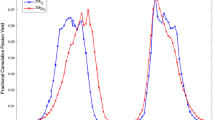Abstract
The statistical basis for the usual analysis of fission track counts obtained by the external detector method is discussed and illustrated with examples. A consequence is that if any observed correlation between counts of spontaneous and induced tracks is due to heterogeneity in the density of uranium, then the model proposed by McGee and Johnson (1979)for assessing the experimental error is inappropriate and results based on it could be misleading. The same remark applies to the method proposed by Johnson, McGee, and Naeser (1979).
Similar content being viewed by others
References
Green, P. F., 1981, A criticism of the paper by Johnson, McGee and Naeser entitled A practical method of estimating standard error of age in the fission track dating method: Nuclear Tracks, v. 5.
Johnson, N. M, McGee, V. E., and Naeser, C. W., 1979, A practical method of estimating standard error of age in the fission track dating method.” Nuclear Tracks, v. 3, p. 93–99.
Kemthorne, O. and Folks, I. L., 1971, Probability, statistics and data analysis: Iowa State University Press.
McGee, V. E. and Johnson, N. M., 1979, Statistical treatment of experimental errors in the fission track dating method: Math. Geol., v. 11, p. 255–268.
Author information
Authors and Affiliations
Rights and permissions
About this article
Cite this article
Galbraith, R.F. On statistical models for fission track counts. Mathematical Geology 13, 471–478 (1981). https://doi.org/10.1007/BF01034498
Received:
Issue Date:
DOI: https://doi.org/10.1007/BF01034498




